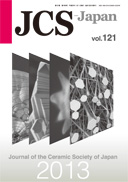Volume 121, Issue 1409
(January)
Displaying 1-27 of 27 articles from this issue
- |<
- <
- 1
- >
- >|
Feature: Ceramics Processing through Energy Consumption Reduction (Green Processing): Review
-
2013Volume 121Issue 1409 Pages 1-9
Published: January 01, 2013
Released on J-STAGE: January 01, 2013
Download PDF (2465K)
Feature: Ceramics Processing through Energy Consumption Reduction (Green Processing): Papers
-
2013Volume 121Issue 1409 Pages 10-12
Published: January 01, 2013
Released on J-STAGE: January 01, 2013
Download PDF (644K) -
2013Volume 121Issue 1409 Pages 13-16
Published: January 01, 2013
Released on J-STAGE: January 01, 2013
Download PDF (469K) -
2013Volume 121Issue 1409 Pages 17-20
Published: January 01, 2013
Released on J-STAGE: January 01, 2013
Download PDF (1351K) -
2013Volume 121Issue 1409 Pages 21-25
Published: January 01, 2013
Released on J-STAGE: January 01, 2013
Download PDF (3356K) -
2013Volume 121Issue 1409 Pages 26-30
Published: January 01, 2013
Released on J-STAGE: January 01, 2013
Download PDF (648K) -
2013Volume 121Issue 1409 Pages 31-35
Published: January 01, 2013
Released on J-STAGE: January 01, 2013
Download PDF (3015K) -
2013Volume 121Issue 1409 Pages 36-39
Published: January 01, 2013
Released on J-STAGE: January 01, 2013
Download PDF (2622K) -
2013Volume 121Issue 1409 Pages 40-44
Published: January 01, 2013
Released on J-STAGE: January 01, 2013
Download PDF (1326K) -
2013Volume 121Issue 1409 Pages 45-48
Published: January 01, 2013
Released on J-STAGE: January 01, 2013
Download PDF (164K) -
2013Volume 121Issue 1409 Pages 49-53
Published: January 01, 2013
Released on J-STAGE: January 01, 2013
Download PDF (3075K) -
2013Volume 121Issue 1409 Pages 54-61
Published: January 01, 2013
Released on J-STAGE: January 01, 2013
Download PDF (2010K) -
2013Volume 121Issue 1409 Pages 62-67
Published: January 01, 2013
Released on J-STAGE: January 01, 2013
Download PDF (971K) -
2013Volume 121Issue 1409 Pages 68-73
Published: January 01, 2013
Released on J-STAGE: January 01, 2013
Download PDF (1624K) -
2013Volume 121Issue 1409 Pages 74-79
Published: January 01, 2013
Released on J-STAGE: January 01, 2013
Download PDF (2068K) -
2013Volume 121Issue 1409 Pages 80-83
Published: January 01, 2013
Released on J-STAGE: January 01, 2013
Download PDF (1133K) -
2013Volume 121Issue 1409 Pages 84-88
Published: January 01, 2013
Released on J-STAGE: January 01, 2013
Download PDF (157K)
Feature: Ceramics Processing through Energy Consumption Reduction (Green Processing): Technical reports
-
2013Volume 121Issue 1409 Pages 89-94
Published: January 01, 2013
Released on J-STAGE: January 01, 2013
Download PDF (2225K) -
2013Volume 121Issue 1409 Pages 95-99
Published: January 01, 2013
Released on J-STAGE: January 01, 2013
Download PDF (1684K)
Feature: Ceramics Processing through Energy Consumption Reduction (Green Processing): Notes
-
2013Volume 121Issue 1409 Pages 100-102
Published: January 01, 2013
Released on J-STAGE: January 01, 2013
Download PDF (312K) -
2013Volume 121Issue 1409 Pages 103-105
Published: January 01, 2013
Released on J-STAGE: January 01, 2013
Download PDF (967K) -
2013Volume 121Issue 1409 Pages 106-108
Published: January 01, 2013
Released on J-STAGE: January 01, 2013
Download PDF (1168K) -
2013Volume 121Issue 1409 Pages 109-112
Published: January 01, 2013
Released on J-STAGE: January 01, 2013
Download PDF (672K) -
2013Volume 121Issue 1409 Pages 113-115
Published: January 01, 2013
Released on J-STAGE: January 01, 2013
Download PDF (182K) -
2013Volume 121Issue 1409 Pages 116-119
Published: January 01, 2013
Released on J-STAGE: January 01, 2013
Download PDF (709K)
Note
-
2013Volume 121Issue 1409 Pages 120-122
Published: January 01, 2013
Released on J-STAGE: January 01, 2013
Download PDF (1139K)
Express letter
-
2013Volume 121Issue 1409 Pages 123-127
Published: January 01, 2013
Released on J-STAGE: January 01, 2013
Download PDF (1625K)
- |<
- <
- 1
- >
- >|
